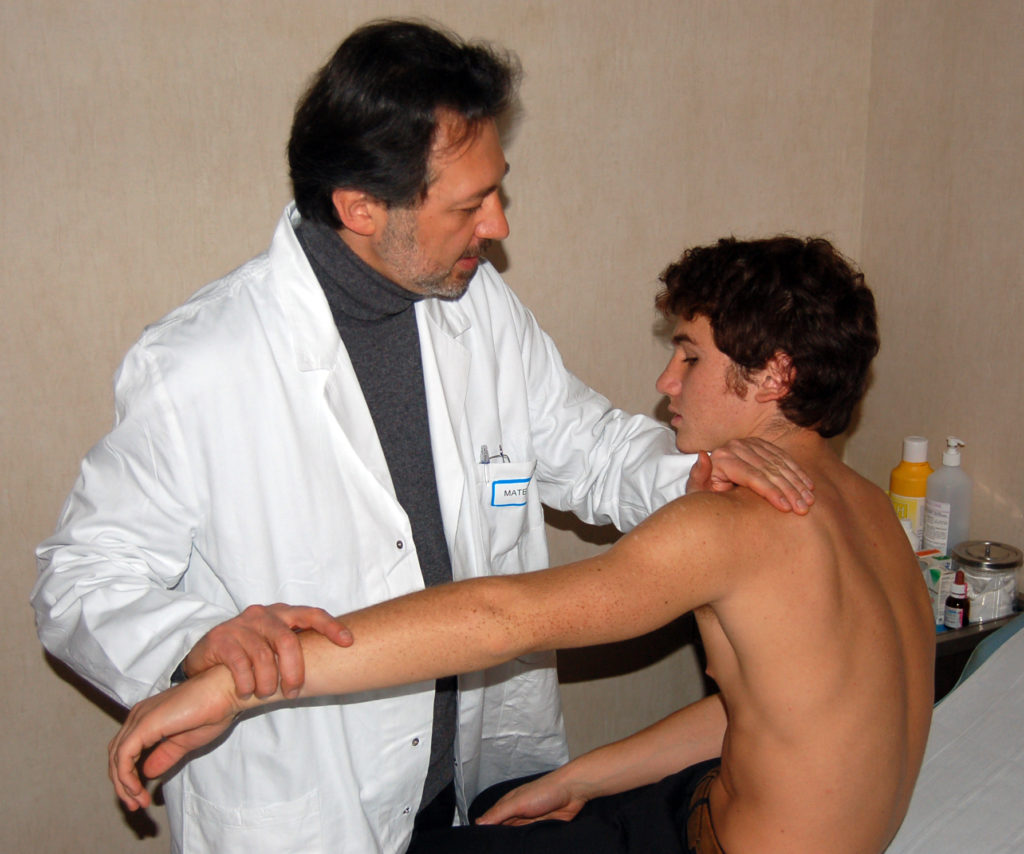Shoulder instability
What is shoulder instability?
Shoulder instability is when the bones of your shoulder go out of place either partially (subluxation), or completely, requiring manipulation back into place (dislocation). Shoulder instability most commonly affects the glenohumeral joint, when the humerus slides out of the glenoid, although it may occur in the acromioclavicular and sternoclavicular joints. When the glenohumeral joint subluxes or dislocates it can tear any, or all, of the following soft tissues: the joint capsule, the labrum (a so-called Bankart lesion, when the labrum tears away from the glenoid), or the attachment of the biceps tendon to the labrum (a so-called SLAP lesion). Instability is a vicious circle – once the shoulder has gone out of alignment once it is more likely to go out of alignment again, further stretching or tearing the soft tissues. If the bones become mis-shapen (due to fractures or dislocations) this may also cause instability, as in the case of a so-called Hill Sachs defect, where the humerus is mis-shapen and no longer moves smoothly within the glenoid socket. If untreated, instability can lead to osteoarthritis.
Although shoulder instability can affect patients of any age, it is often seen in younger patients (under 30 years old).
What causes it?
The joint capsule ligaments and rotator cuff muscles in a healthy shoulder should be strong enough to hold the bones in place. But if these tissues become weakened or damaged, or an excessive force is applied, they can no longer hold the bones in the correct position. Therefore instability commonly begins with a sporting injury, a major accident or fall (onto your elbow, shoulder or outstretched arm), or as a result of a congenital defect (the ligaments are too elastic). Instability may also be caused by repeated small traumas rather than one specific injury, and is therefore common among athletes who take part in throwing sports (cricket, baseball etc.) or in sports that require you to raise your arms above your head (e.g. swimming, tennis etc.).
How does it feel?
The upper arm usually feels weak. When you raise your arm above your head Your shoulder may feel loose – as if it will dislocate. You will feel a sharp pinching pain if the joint subluxes. If the joint dislocates, any shoulder movement will cause intense pain and the joint will look abnormal.
Diagnosis
Your medical history (past shoulder injuries, problems with movement) and a physical examination should be enough for your doctor to be able to diagnose shoulder instability. In the physical exam the doctor will carry out a number of specific tests to check the mobility of your shoulder and how you feel when you make certain movements, and he will test the strength of the ligaments. He may ask for an X-ray to check that there are no bone fractures, or an MRI (magnetic resonance imaging) scan to check the condition of the soft tissues.
Treatment – conservative
If your shoulder is dislocated, the first treatment will be to manipulate it back into place. Then your doctor may prescribe a sling to rest your shoulder, ice-packs, or pain-killers. Then he will give you physiotherapy exercises to improve your range of movement, but avoiding activities that could cause further dislocations. Over time you will need to strengthen the various muscles of your shoulder and retrain them so that they can hold the humerus in place and prevent future instability.
Treatment – surgical
Glenohumeral instability
– Arthroscopic Bankart repair: your surgeon will make 3 or 4 tiny incisions around the glenohumeral joint through which he will insert a fibre-optic camera (arthroscope) and the surgical instruments required to perform the operation. First, the surgeon will remove any damaged tissue on the labrum, and then he will re-attach it to the glenoid bone socket using suture anchors – tiny metal/soluble plastic screws that are drilled into the bone and to which the labrum is attached with stitches.
– Glenoid reconstruction: this procedure may be performed in cases of instability where the bone of the glenoid socket has become severely damaged due to repeated subluxations/dislocations. The surgeon will make a 4-5cm incision on the front of the shoulder, and then cut the tip off the end of the coracoid process. He will then transfer this piece of bone to the site of the damage on the glenoid and attach it to the bone socket with screws. Then he will reattach the labrum.
Acromioclavicular subluxation
– Open AC joint stabilisation: if one of the ligaments is completely torn, the surgeon will perform an “open” procedure, making a 6-7cm incision, through which he will re-attach the clavicle to the acromion. To do this, the surgeon will remove the end of the clavicle bone and re-attach another ligament onto the cut surface of the clavicle. This ligament graft will be held in place with strong stitches.
Rehabilitation after surgery
You will have to wear a sling for about 4 weeks after surgery, and you should use your non-operated arm to carry out everyday activities such as eating and dressing. You will start physiotherapy to regain your range of movement immediately after the operation although initially this will involve passive movements where the physiotherapist will move your arm for you. After about 6 weeks you will start more strenuous active exercises to rebuild and strengthen the shoulder muscles. You will need to do a regular exercise/physiotherapy programme for at least 3 months after surgery
When will I be back to normal?
Depending on your speed of recovery, you should be able to drive after 4-6 weeks after surgery, and to return to non-contact sports after 2-3 months. Contact sports should be avoided for at least 9 months after the operation. Office workers should be able to get back to work about 4 weeks after surgery, whereas manual workers will have to wait until they have regained a full range of movement and sufficient muscle strength for the type of work they do.
